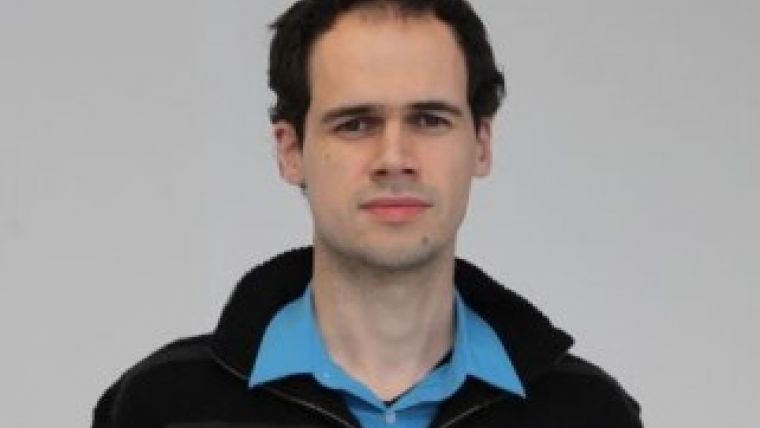The Rapid Rise of UAS in Geomatics
GIM International Interviews Peter Cosyn
Peter Cosyn co-founded Gatewing in 2012. The start-up company’s X100 fixed-wing UAS soon attracted interest from Trimble, which acquired the company in 2012. In this interview with GIM International, Peter provides insights into the company’s evolution and shares his thoughts on the future.
Gatewing was founded as a spin-off from your PhD research at Ghent University. How did you experience the transition from a scientific environment to running a company?
My PhD research involved micro air vehicle development and optimisation. Such vehicles are only about the size of a big smartphone, so the research did not have much in common with what we later did at Gatewing and it was a significant transition. Although the two other co-founders, Maarten Vandenbroucke and Maarten Van Speybroeck, came from a business environment, running a start-up was new for them too. I benefited from my PhD experience. For example, I had to apply for government funding for my PhD and post-doc, which meant I knew how to attract innovation funding. At the university, I had to work independently, think ‘out of the box’ and work in a team with others to explore unmanned aerial solutions (UAS) as I could not rely on a ‘UAS lab.’ My lab consisted of experts in computational fluid dynamics (flow simulation), not UAVs. So that experience helped as well. In general, starting the business was a real endeavour but we were eager to learn from business experts while trusting our ideas and gut feelings about the market. We made a prototype and checked it with a few key accounts such as big mining companies. Then we just went for it and started developing the Gatewing X100.
What were the main hurdles to overcome in the design and operationalisation of the X100, and what are its distinguishing features compared to other fixed-wing UAS?
A big hurdle was the fact that we were not experts in autopilot or control design. I had experience in wing design, aerodynamics and propulsion. My colleague, Maarten Van Speybroeck, had the most experience in CAD and knew a lot about manufacturing and materials. We had to learn it the hard way, making prototypes and testing them. The major issue here was that a UAS is not that forgiving if you make a mistake. You need to be resilient when gathering up the broken pieces of a prototype you’ve been working on for days and that cost you a significant chunk of your limited funds. Today, with all the open-source platforms, making a UAS might seem straightforward. But making it reliable, industrialising its design and manufacturing, and ensuring compliance with FCC, CE and other organisations actually involves following a long, arduous path.
The fact that we were not RC (radio-controlled aircraft) enthusiasts probably helped us develop a system intended for professionals who lacked ‘piloting skills’. A distinguishing feature of the X100 compared with other (at that time typically bigger or rotary-type) UAS on the market was that it was completely autonomous from start to landing, with user interaction limited to simple commands (land, go home, etc). This reduced the barriers to entry for the commercial market. Manually assisted landing and pilot ‘override’ for take-off, landing or emergency was still the norm when we started and it is still an aspect of many UAS.
An additional distinguishing feature was the foam structure we used with internal composite reinforcements. We basically did the opposite of what was common for most (military) fixed-wing UAS. It gave us an advantage in production, plus resistance to shock and a significant improvement in safety. This looked important so we went for a patent.
The X100 is one of the few fixed-wing UAS on the market. What are its main strengths and weaknesses compared to rotary wings?
A fixed wing has an important advantage: it benefits from wing lift enabling it to fly efficiently at high speed, whereas a rotary UAV does not. This means that a fixed-wing UAS of comparable size and weight will be able to map a much bigger surface than a rotary UAS in a given amount of time. Knowing that size of the airframe impacts the costs of acquiring and operating a UAS and also the risks (and regulations) involved, it is clear that fixed wings have an advantage for mapping. There is a trade-off and it depends on the size of the area covered. A Gatewing X100 or Trimble UX5 is a good match when users need to cover from tens of hectares up to tens of square kilometres. Meanwhile, if you just need to fly and map a building or a small field, a rotary UAS of the same scale might do just fine. In addition, rotary UAS are a match when you need vertical surveying (e.g. of buildings) or you need to take off and land in a very enclosed area. A disadvantage of a traditional fixed wing is that it needs significant space to land, whereas a rotary wing can take off and land vertically. The UX5 addresses this limitation with its steep take-off and landing capability.

Value staying current with geomatics?
Stay on the map with our expertly curated newsletters.
We provide educational insights, industry updates, and inspiring stories to help you learn, grow, and reach your full potential in your field. Don't miss out - subscribe today and ensure you're always informed, educated, and inspired.
Choose your newsletter(s)
























